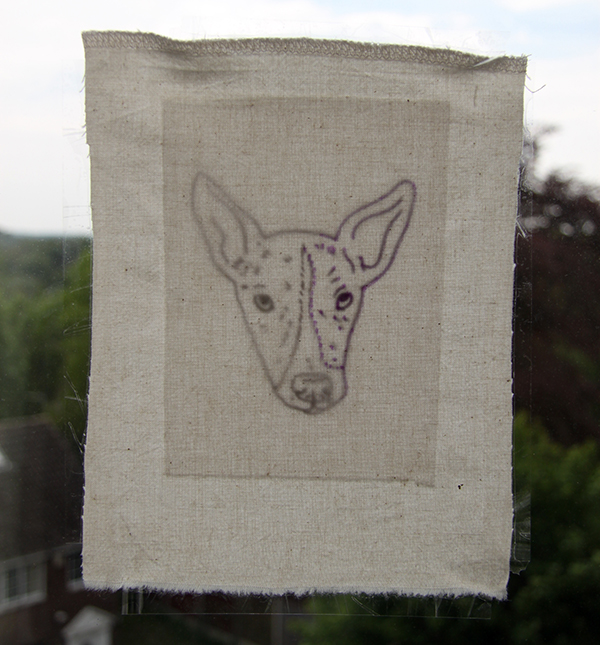How Do You Upload an Image to Create a Pattern to Embroider on Fabric
Manus Embroidery Patterns: Converting Pictures to Stitches
Manus embroidery patterns are a smashing way to create imagery in floss. But what if you can't discover the exact blueprint your looking for? Or you accept a specific photo you want to stitch? What steps can you lot take to catechumen a picture to an embroidery blueprint?
 Photos via Leighlalovesyou
Photos via Leighlalovesyou
Here are tips to translate your images into embroidery patterns!
The pet portrait in a higher place volition provide u.s. with an image guide for creating an embroidery design. Although the stitching technique used for this slice were free-hand auto embroidery, the process and steps taken are the same with any hand stitching.
Stride 1: Creating the outline
You have selected your image/photo, and at present yous demand to get in into a pattern- but how? Don't worry if you lot're not a sketch creative person, here are a few steps to go you on track:
1. Tracing is not cheating: Don't be afraid to use tracing newspaper to get an outlines just right.'
two. Don't worry about detail: Go as much every bit you feel comfy with. It doesn't have to have 1,001 lines for information technology to await exact. By picking up the right elements you can brand the image look effective only not overdone.
3. Remember the stitch: Don't forget, you accept to convert these pencil lines to embroidery thread, then consider thickness and closeness of lines and how this volition be translated later on.
iv. Use technology! There are tons of ways you can catechumen your image on your computer, rather than by manus. Websites or software like Adobe Photoshop can put your image through a filter to give information technology a simpler outline!
 Outline pattern drawn onto paper.
Outline pattern drawn onto paper.
Footstep 2: Transferring the image to fabric
Outline at the fix, but how do you lot put it onto fabric? Many of you will have experience using embroidery patterns, and volition have your own tried and tested techniques. If you lot haven't, in that location are many ways your image can brand information technology's way from paper to textile, so here are a few ideas to get you going:
1. Using a lite box tin be very effective. Withal, you don't demand expensive equipment to get results- just use a window! Taping your outline onto the glass, and then your material on top means you lot can trace the image directly, either in pencil or water soluble material pen. Another method would be to utilize your computer screen equally a light box, tracing directly from digital outline to fabric.
2. Carbon paper is probably the simplest method of transference. Just place the carbon paper between your paper outline and your fabric, then trace away!
3. Water soluble stabilizer is a great way to transfer an image onto darker fabrics. Trace your design onto the stabilizer and place on meridian of your fabric. Stitch through both the stabilizer and textile layers, then soak the stabilizer away before you lot practice your filling stitches. Wild Olive explains this procedure perfectly!
 Tracing outline from newspaper to cloth using a window as a lite box
Tracing outline from newspaper to cloth using a window as a lite box
Step iii: Stitching
If yous're not a seasoned stitcher, the next part could be a piffling scary. Don't worry, we've got it covered:
1. Recollect about your outline: Volition information technology friction match the interior colors or be a bold contrasting colour (i.e. black outline with colors inside). What type of stitch would work best for this?
2. Consider your color palette. Are you going to stick with colors from the original image or choose your ain? Don't exist agape to mix it up! Selecting a limited amount of colors can also await great, and y'all tin can coordinate them with surround (e.g. the photo frame, the rooms interior tones).
3. Using a "color by numbers" blazon technique to build up layers of tone can be really effective. I frequently work from light to dark, but information technology can depend on the project. Mark the areas that your going to stitch with a water soluble pen and sew together one tone at a time.
4. Be experimental with your stitches. Consider stitch direction for areas such as hair or fur to add realism and texture.
 Working from light to dark
Working from light to dark
Finally, practice not put also much pressure level on yourself to brand the embroidery wait exactly like the original image. Think, the materials and techniques of creation have changed, they're not going to exist exact matches. Plus, office of the fun is giving information technology a new lease of life, and putting your own personal stamp on information technology!
[box blazon="shadow"]
If this all sounds exciting, but you're yet non totally clear on where to begin, why not try 1 of our online classes?Design It, Stitch It: Hand Embroidery with Jessica Marquez has it covered! Or, expand your embroidery skill set with Kristin Nicholas in Stitch It with Wool: Crewel Embroidery!
[/box]
What photo will y'all catechumen to embroidery?
Source: https://www.craftsy.com/post/how-to-convert-a-picture-to-an-embroidery-pattern/
0 Response to "How Do You Upload an Image to Create a Pattern to Embroider on Fabric"
Post a Comment